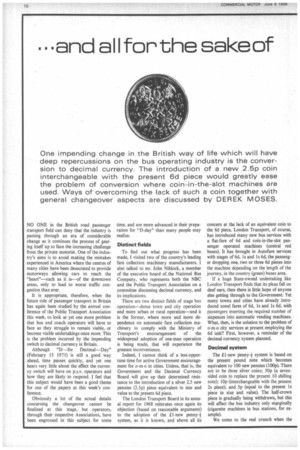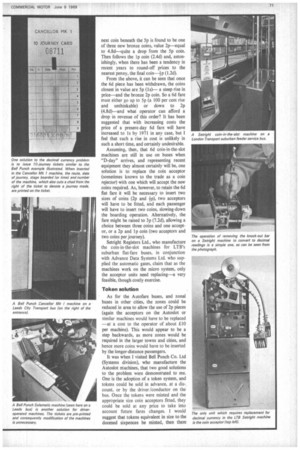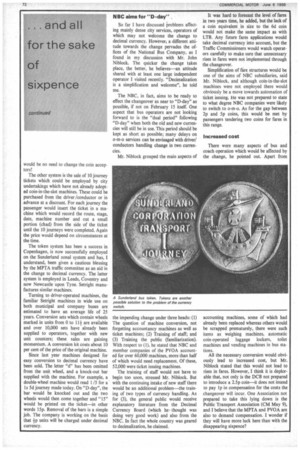...and all for the sakeof
Page 72

Page 73

Page 74

If you've noticed an error in this article please click here to report it so we can fix it.
One impending change in the British way of life which will have deep repercussions on the bus operating industry is the conversion to decimal currency. The introduction of a new 2.5p coin interchangeable with the present fid piece would greatly ease the problem of conversion where coin-in-the-slot machines are used. Ways of overcoming the lack of such a coin together with general changeover aspects are discussed by DEREK MOSES.
NO ONE in the British road passenger transport field can deny that the industry is passing through an era of considerable change as it continues the process of gear ing itself up to face the increasing challenge from the private motorist. One of the industry's aims is to avoid making the mistakes experienced in America where the centres of many cities have been desecrated to provide motorways allowing cars to reach the "heart"—such as it is—of the downtown areas, only to lead to worse traffic congestion than ever.
It is appropriate, therefore, when the future role of passenger transport in Britain has again been studied by the annual conference of the Public Transport Association this week, to look at yet one more problem that bus and coach operators will have to face as they struggle to remain viable, or become viable undertakings once more. This is the problem incurred by the impending switch to decimal currency in Britain.
Although "D—for Decimal—Day" (February 15 1971) is still a good way ahead, time passes quickly, and yet one hears very little about the effect the currency switch will have on p.s.v. operators and how they are likely to respond. I feel that this subject would have been a good theme for one of the papers at this week's conference.
Obviously a lot of the actual details concerning the changeover cannot be finalized at this stage, but operators, through their respective Associations, have been engrossed in this subject for some time, and are more advanced in their preparation for "D-day" than many people may realize.
Distinct fields
To find out what progress has been made, I visited two of the country's leading fare collection machinery manufacturers. I also talked to mr. John Niblock, a member of the executive board ofithe National Bus Company, who represents both the NBC and the Public Transport Association on a committee discussing decimal currency, and its implications.
There are two distinct fields of stage bus operation—dense town and city operation and more urban or rural operation—and it is the former, where more and more dependence on automatic fare collection machinery to comply with the Ministry of Transport's encouragement of the widespread adoption of one-man operation is being made, that will experience the greatest inconvenience.
Indeed, I cannot think of a less-opportune time for active Government encouragement for o-m-o in cities. Unless, that is, the Government and the Decimal Currency Board will give up their determined resistance to the introduction of a silver 2.5 new pennies (2.5p) piece equivalent in size and value to the present 6d piece.
The London Transport Board in its annual report for 1968 reiterates once again its objection (based on reasonable arguments) to the adoption of the £1-new penny4 system, as it is known, and above all its
concern at the lack of an equivalent coin to the 6d piece. London Transport, of course, has introduced many new bus services with a fiat-fare of 6d and coin-in-the-slot passenger operated machines (central red buses). It has brought in Autofare services with stages of 6d, Is and Is 6d, the passenger dropping one, two or three 6d pieces into the machine depending on the length. of the journey, in the country (green) buses area.
If a huge State-owned undertaking like London Transport finds that its pleas fall on deaf ears, then there is little hope of anyone else getting through to the Government. Yet many towns and cities have already introduced zonal fares of 6d, ls and Is 6d, with passengers inserting the required number of sixpences into automatic vending machines. What, then, is the solution to the problem of o-m-o city services at present employing the 6d unit? First, however, a reminder of the decimal currency system planned.
Decimal system
The £1-new penny-4 system is based on the present pound note which becomes equivalent to 100 new pennies (100p). There are to be three silver coins; 50p (a sevensided coin to replace the present 10 shilling note); 10p (interchangeable with the present 2s piece); and 5p (equal to the present Is piece in size and value). The half-crown piece is gradually being withdrawn, but this will affect the bus industry only marginally (cigarette machines in bus stations, for example).
We come to the real crunch when the next coin beneath the Sp is found to be one of three new bronze coins, value 2p—equal to 4.8d—quite a drop from the Sp coin. Then follows the lp coin (2.4d) and, astonishingly, when there has been a tendency in recent years to round-off prices to the nearest penny, the final coin-4p (lid).
From the above, it can be seen that once the 6d piece has been withdrawn, the coins closest in value are Sp (1s)— a steep rise in price—and the bronze 2p coin. So a 6d fare must either go up to Sp (a 100 per cent rise and unthinkable) or down to 2p (4.8d)—and what operator can afford a drop in revenue of this order? It has been suggested that with increasing costs the price of a present-day 6d fare will have increased to Is by 1971 in any case, but I feel that such a rise in cost is unlikely in such a short time, and certainly undesirable.
Assuming, then, that 6d coin-in-the-slot machines are still in use on buses when "D-day" arrives, and representing recent equipment they almost certainly will be, one solution is to replace the coin acceptor (sometimes known to the trade as a coin rejector) with one which will accept the new coins required. As, however, to retain the 6d flat fare it will be necessary to insert two sizes of coins (2p and +p), two acceptors will have to be fitted, and each passenger will have to insert two coins, slowing-down the boarding operation. Alternatively, the fare might be raised to 3p (7.2d), allowing a choice between three coins and one acceptor, or a 2p and lp coin (two acceptors and two coins per journey).
Setright Registers Ltd., who manufacture the coin-in-the-slot machines for LTB's suburban flat-fare buses, in conjunction with Advance Data Systems Ltd. who supplied the automatic gates, claim that as the machines work on the micro system, only the acceptor units need replacing—a very feasible, though costly exercise.
Token solution As for the Autofare buses, and zonal buses in other cities, the zones could be reduced in area to allow the use of 2p pieces (again the acceptors on the Autoslot or similar machines would have to be replaced —at a cost to the operator of about £10 per machine). This would appear to be a step backwards, as more zones would be required in the larger towns and cities, and hence more coins would have to be inserted by the longer-distance passengers.
It was when I visited Bell Punch Co. Ltd (Systems division), who manufacture the Autoslot Machines, that two good solutions to the problem were demonstrated to me. One is the adoption of a token system, and tokens could be sold in advance, at a dis-, count, or by the driver /conductor on the bus. Once the tokens were minted and the appropriate size coin acceptors fitted, they could be sold at any price to take into account future fares changes. I would suggest that tokens equivalent in size to the doomed sixpences be minted, then there would be no need to change the coin acceptors!
The other system is the sale of 10 journey tickets which could be employed by city undertakings which have not already adopted coin-in-the-slot machines. These could be purchased from the driver/conductor or in .advance at a discount. For each journey the passenger would insert the ticket in a machine which would record the route, stage, date, machine number and cut a small portion (chad) from the side of the ticket until the 10 journeys were completed. Again the price would depend on circumstances at the time.
The token system has been a success in Copenhagen, is now successfully employed on the Sunderland zonal system and has, I understand, been given a cautious blessing by the MPTA traffic committee as an aid in the change to decimal currency. The latter system is employed in Leeds, Coventry and now Newcastle upon Tyne. Setfight manufactures similar machines.
Turning to driver-operated machines, the familiar Setright machines in wide use on both municipal and company buses are estimated to have an average life of 25 years. Conversion sets which contain wheels marked in units from 0 to 11-1are available and over 10,000 sets have already been supplied to operators, together with new unit counters; these sales are gaining momentum. A conversion kit costs about 10 per cent of the price of the original machine.
Since last year machines designed for easy conversion to decimal currency have been sold. The letter "d" has been omitted from the unit wheel, and a knock-out bar supplied with the machine. For example, a double-wheel machine would read 1 /5 for a is 5d journey made today. On "D-day", the bar would be knocked out and the two wheels would then come together and "15" would be printed on the ticket—in other words 15p. Removal of the bars is a simple job. The company is working on the basis that fp units will be charged under decimal currency.
NBC aims for "D-day'.
So far I have discussed problems affecting mainly dense city services, operators of which may not welcome the change to decimal currency. However a different attitude towards the change pervades the offices of the National Bus Company, as I found in my discussion with Mr. John Niblock. The quicker the change takes place, the better, he believes—an attitude shared with at least one large independent operator I visited recently. "Decimalization is a simplification and welcome", he told me.
The NBC, in fact, aims to be ready to effect the changeover as near to "D-day" as possible, if not on February 15 itself. One aspect that bus operators are not looking forward to is the "dual period" following "D-day" when both the old and new currencies will still be in use. This period should be kept as short as possible; many delays on o-m-o services can be envisaged with driver/ conductors handling change in two currencies.
Mr. Niblock grouped the main aspects of the impending change under three heads: (1) The question of machine conversion, not forgetting accountancy machines as well as ticket machines; (2) Training of staff; and (3) Training the public (familiarization). With respect to ( I), he stated that NBC and member companies of the PVOA accounted for over 60,000 machines, more than half of which would need replacement. Of these, 52,000 were ticket issuing machines.
The training of staff would not have to begin too soon, stressed Mr. Niblock. But with the continuing intake of new staff there would be an additional problem—the training of two types of currency handling. As for (3), the general public would receive explanatory literature from the Decimal Currency Board (which he thought was doing very good work) and also from the NBC. In fact the whole country was geared to decimalization, he claimed. It was hard to forecast the level of fares in two years time, he added, but the lack of a coin equivalent in size to the 6d coin would not make the same impact as with LTB. Any future fares applications would take decimal currency into account, but the Traffic Commissioners would watch operators carefully to make sure that unnecessary rises in fares were not implemented through the changeover.
Simplification of fare structures would be one of the aims of NBC subsidiaries, said Mr. Niblock, and although coin-in-the-slot machines were not employed there would obviously be a move towards automation of ticket issuing. He was not prepared to state to what degree NBC companies were likely to switch to o-m-o. As for the gap between 2p and 5p coins, this would be met by passengers tendering two coins for fares in this range.
Increased cost
There were many aspects of bus and coach operation which would be affected by the change, he pointed out. Apart from accounting machines, some of which had already been replaced whereas others would be scrapped prematurely, there were such items as weighing machines, automatic coin-operated luggage lockers, toilet machines and vending machines in bus stations.
All the necessary conversion would obviously lead to increased cost, but Mr. Niblock stated that this would not lead to rises in fares. However, I think it is deplorable that, not only is the DCB not prepared to introduce a 2.5p coin—it does not intend to pay lp in compensation for the costs the changeover will incur. One Association not prepared to take this lying down is the Public Transport Association (CM May 9), and I believe that the MPTA and PV0A are also to demand compensation. I wonder if they will have more luck here than with the disappearing sixpence?


























































































































